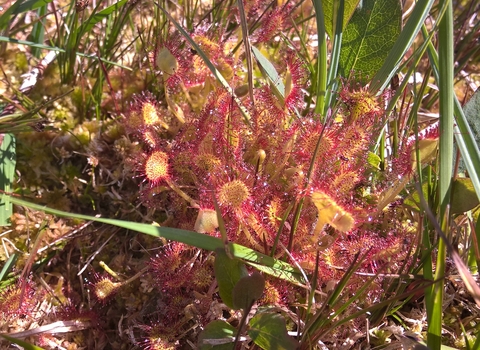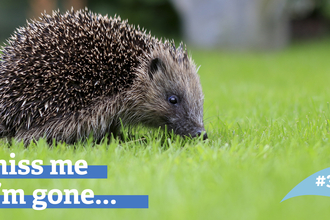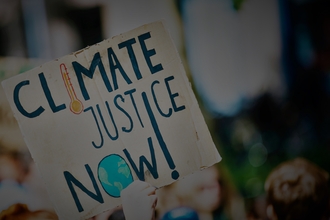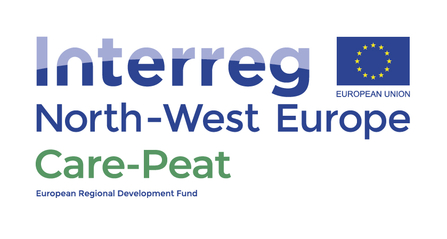
At Cors y Sarnau Nature Reserve we are working with international partners to improve our understanding of peatland processes, restore habitats and contribute to the Wildlife Trusts' 30 by 30 campaign.
Taking care of peatlands
North Wales Wildlife Trust has joined an innovative new project working across Europe to protect peatlands. Care-Peat is an Interreg North-West Europe (NWE) project with 12 partners working together to reduce carbon emissions and restore the carbon storage capacity of different types of peatlands in North-West Europe. The main partnership consists of seven knowledge institutes and five nature organisations from Belgium, France, Ireland, the Netherlands and the United Kingdom. Together with five sub-partners and 47 associated partners, Care-Peat is developing and testing new techniques and socio-economic strategies for carbon reduction. The project has an overall budget of €7.03 million, with €4.2 million provided by the EU. In North Wales the project will run from May 1st 2021 until December 2023. One of the pilot sites involved in the project is Cors y Sarnau Nature Reserve, near Bala.
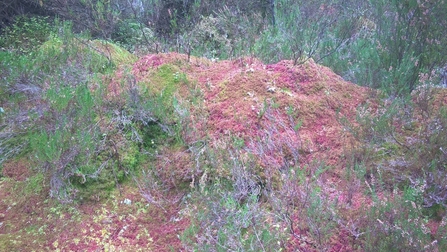
A hummock of sphagnum moss species / Twmpath o rywogaethau o fwsogl sffagnwm. © NWWT Chris Wynne
Peatlands tackling climate change
Why focus on peatlands? Peatlands are not only habitats with a highly specialised flora and fauna, they also play an important role in global climate regulation. Peatlands in the Northern hemisphere account for 3% to 5% of total land area and contain approximately 33% of global soil carbon. Therefore, peatlands have a significant natural potential to save carbon and play an important role in nature based solutions for climate change.
When peatlands are drained, the well preserved carbon is released as greenhouse gases to the atmosphere. That is why it is important to keep peatlands wet. Unfortunately, many peatlands are degraded and emit rather than store carbon. The global annual greenhouse gas emissions from drained organic soils are twice that from aviation. We need to act now to prevent further degradation and encourage more recovery of our remaining peatlands.
What does Care-Peat do?
The main goal of Care-Peat is to set up and demonstrate innovative technologies for new restoration and carbon measurement techniques and involve local and regional stakeholders.
Therefore the nature organisations, together with local landowners, are restoring peatlands of seven different pilot sites ranging from one to 250 hectares and demonstrating the (potential) carbon savings of the restoration. For each pilot site different restoration techniques are used - from manual management to growing additional peat moss. Throughout the project the organisations are supported by the knowledge institutes that work together to develop and test new equipment, methods and models to predict carbon flows (e.g. by the use of drones and satellites to guide restoration and provide input for carbon models). Care-Peat also works with innovative companies in the field of restoration and develops partnerships with local and regional stakeholders to increase the impact of pilots and maximise socio-economic benefits.
Important outputs of Care-Peat are the publication of a management and decision support tool and a set of socio-economic models concerning the best options for peatland restoration in regard to carbon storage. This way the results of the project are transferred and replicated to users across North-West Europe to determine the most appropriate management measures, even after Care-Peat has ended.
In 2021, as part of the Interreg NWE programme, the Care-Peat project was given the opportunity to strengthen its scope with a so called ‘capitalisation project’. The aim is to apply the project results to new areas and a new target group in North-West Europe. The approval resulted in no less than three new partners and six new associated partners who joined our consortium. The North Wales Wildlife Trust was one of the new partners.
In the capitalisation project we are developing a unified methodology for assessing GHG emissions from peatlands, that is widely applicable in North-West Europe (different peatland types and regions), and thus increase the impact of the decision support tool. Also we include farmers and farmer organisations as a new main target group by engaging with them directly and incorporating best practices for carbon savings on farmland.
How much carbon can be saved?
Care-Peat is ambitious. By the end of the project in 2023, we expect that about 8,137 tonnes of carbon emissions per year will be prevented from losses and stored in the seven pilot sites (in total approximately 645 hectares).
After 2023 we hope that nature conservation and other organisations all over the North-West Europe region will take further measures, resulting in the restoration of many more peatlands. And the more peatlands are restored, the more carbon is saved. In this way peatlands can become an important natural partner in climate policies across North-West Europe.
What will be happening at Cors y Sarnau?
Cors y Sarnau, which has been managed by the North Wales Wildlife Trust since since 1972 now covers over 28 hectares. This former lake site is notable for its representation of the transition from fen to bog vegetation. In 2016, the Wildlife Trust was able to purchase and then fell an area of conifer plantation with the ambitious aim of restoring peatland habitat. The relative importance of this work increases as more and more similar peatland sites in Wales are drained or destroyed. We are able to carryout this work thanks to funding from the Care-Peat Project and Natural Resources Wales.
The planned work will be crucial in helping the restoration of a diverse and vibrant peatland community. Base-line data collected just prior to the felling will be re-visited and expanded to better inform and direct habitat management and a range of techniques to manipulate and set the scene for the natural regeneration of the wetland communities, including carpets of Sphagnum mosses.
Habitat management will focus on restoration of the open peatland habitats at the southern end of Cors y Sarnau; meanwhile at the northern end of the site – the former conifer plantation known as Coed Ty Uchaf – the focus will be on larger scale intervention to create the correct conditions for the development of peatland habitat.
We will also work with Manchester Metropolitan University to monitor greenhouse gas levels to see how quickly the site can be transformed as a carbon store. The research data gleaned from the site will be used to support the adoption of this and other alternative land management techniques for our peatlands.
Disseminating what we learn and involving the local community at Cors y Sarnau is an important dimension of the project. As part of this work we will be holding regular events which will be announced via social media.

